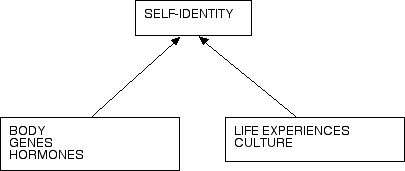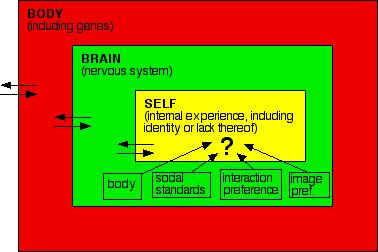Does Biology Have Anything to Contribute to Thinking About Sex and Gender?
Paul Grobstein
General Programs 290
Bryn Mawr and Haverford Colleges
5 October 2005
First Session
Embodiment and the Brain
"In any genetic history. I'm the final clause in a periodic sentence, and that sentence begins a long time ago, in another language, and you have to read it from the beginning to get to the end, which is my arrival" ... Middlesex (see also The Birds, the Bees, and 5-alpha Reductase Deficiency)
PG:
Biology (like all science) doesn't answer questions (or solve problems) but it may (depending on one's degree of familiarity with it and other aspirations/commitments) provide observations and perspectives that are novel and useful for developing improved stories about particular phenomena (including sex and gender?). It does so only by gathering large numbers of observations, telling stories about them, and treating the stories with skepticism, through a continual and recursive process of "getting it less wrong". As is the case with all story-generating systems, biology (and science) creates risks as well as benefits in this regard.
Some relevant areas re "sex and gender":
Evolution
Genesis
Material body
- Appearance/function
- Brain
- Self
- Cultural influences
|
Let's take material body and genesis for today
Leave evolution for next time.
Thinking about body/culture/self ...
| A starting place | Adding a biological perspective |
|---|
sex = biology
gender = culture
identity = ?
| 
| "culture" is not independent of "biology" nor "biology" of "culture"
"self" is influenced by both and is a contributor to both
architecture important: self is to brain as culture is to individual
both "sex" AND "gender" are "social constructs"; so too are both "biology" and "culture"
|
Is this a good story? What are the problems with it?
|
Self can be different from body AND experience/culture TOGETHER
Nervous system and rest of body can conflict
Self can change rest of body
|
Applying the story to individuals ...
From Jenny Boylan:
- "plumbing and electricity work fine"
- "enlarged bed nucleus of stria terminalis"
- "knew from inside that I was a girl"
- "gender preference" ... "gender identity" ... ?
Relevant to one's own story: there seem to be at least four signals from presumably four different brain regions that may be but are not necessarily congruent with one another
- in terms of binaries, there are 16 "sexes/genders" (where did 2 come from, if not from biology)
- not hard to understand, since each region is product of complex and to some degree independent development (like other parts of body)
- since each characteristic is actually continuous, there are many more, multiple "bell curves"
- variation is not deficiency (see Diversity and Deviance: A Biological Perspective and Culture as Disability)
- The situation is further complicated/enriched by a capacity of the self not only to adjudicate but to alter, with varying degrees of difficulty.
- Differences may result from genes, and/or a variety of other factors.
- Is useful for many people to have support for "knew from inside from a very young age" so they don't feel shame/guilt/personal frustration, but also raises specter of eugenics (issue not of observations but of "social construction", to return to).
Questions that arise:
- what/where are the brain regions? is there a "social standards" brain region? how does it work? can one explore "culture" in the brain?
- what/where is a "self" brain region? how are inputs adjudicated there?
- what in terms of neurons is a tolerable mismatch? one that requires action?
- given variability in brains, why is "culture" so concerned with binaries? can that be changed? how? .... issue of "social construction"
To be continued ...
|
Post presentation notes
Neglected to point out 5 and its significance
Need to look at evolution, development to deal more with 2,4,6
"Cultural norms" are themselves a story, one that can be affected by individuals
A biologist or "biologists"? - see Revisiting Science in Culture: Science as Story Telling and Story Revising
Seen on yellow triangle: bi=taking gender out of the equation
interesting issue, related one raised in class; are oppressive categories best dealt with by removing considerations used in existing categories or be increasing the number of categories?
|
| Science in Culture
| Serendip Home |
Send us your comments at Serendip

© by Serendip 1994-
- Last Modified:
Wednesday, 02-May-2018 10:51:31 CDT


